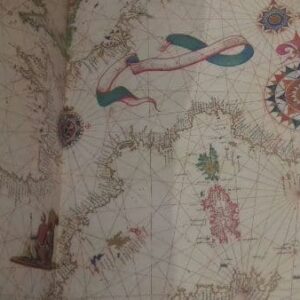Description
The Atlas Luis Lazarus at hand thanks to this beautiful facsimile reproduction. The Atlas of Lazaro Luis, made in 1593, is one of the most important cartographic documents of the sixteenth century, a codex of extraordinary beauty in which the author is a man of his time, knowledgeable, curious and meticulous, and provided a wide culture that borders on scholarship.
The authorship is marked on one of the leaves, which are using those below a picture of Our Lady with the child in his arms: “LAZARO LUIS, this liuro all faiths Vniuerço EFOI na ho was seseta thousand quintets I have three years “(see photo). Some say he was born in India, due to the detail that draws the coasts of Southeast Asia. The study of charts, drawings and phrases, data reveals a highly cultured and erudite personality.
The Atlas consists of ten sheets of parchment whose dimensions are 61.3 x 43.2 cm. In this codex it is represented by the contents of the Atlas continents (Europe, Asia, Africa and America). One can say that in the Atlas Luis Lazarus plays the coastal silhouette around the coastal area known so far. It also functions as a “talking” Atlas, a textbook teaching through the image, and a good example is the illustrations with which he has given life to their maps: meticulous drawings of figures of men and women (a caravan crossing the Sahara desert into an oasis resting); flora (equatorial latitudes Amazonian vegetation); human settlements (indigenous villages in Latin); strengths (in the areas of passage between East and West), as well as large cities such as Alexandria, Jerusalem and holy places like Mecca and heraldic elements (flags and wreaths on respective territories).
As for the distribution of materials, the Atlas is organized as follows: sheets 1 and 2 are cosmographic (regiments rules and nautical stars) content; leaf from 3R to 9R is properly reproduce cartographic maps, together with the information and symbolism of each plate; 9V sheet includes texts concerning numerical tables and movable feasts during the year, playing with the “golden ratio” and “Sunday letter” on the date of the making of the work. The 10V sheet contains a large drawing and a legend at the bottom, with the dating of the year in which it was designed. In total, therefore, the Atlas contains 20 pages, illuminated with gold on both sides, except for the 10R.
This sensational Atlas, hence its realization as the historical importance that is available in facsimile, numbered limited edition by the notary. Plays with accuracy the MS-14-1 manuscript kept in the Sciences Academy of Lisbon and has been printed on special parchment paper, with the same thickness, feel and smell as the original. Certainly, since the original is in a safe place, it is the closest I can come to be of such exceptional work that, otherwise, we should be content with seeing on the screen of a computer or poorly replicated.
2006 facsimile edition, large format. Characteristics:
Facsimile format 44.5 x 62.5 cm, bound in parchment. Affidavit. Book study format 44 x 61.5 cm in bilingual Spanish-Portuguese. All this in a box-case 47.5 x 66 x 6 cm.
New article, in its original packaging, brand new.
Shipping by the buyer, upon request and destination. Ask us any questions and any other fax you are looking for.
















